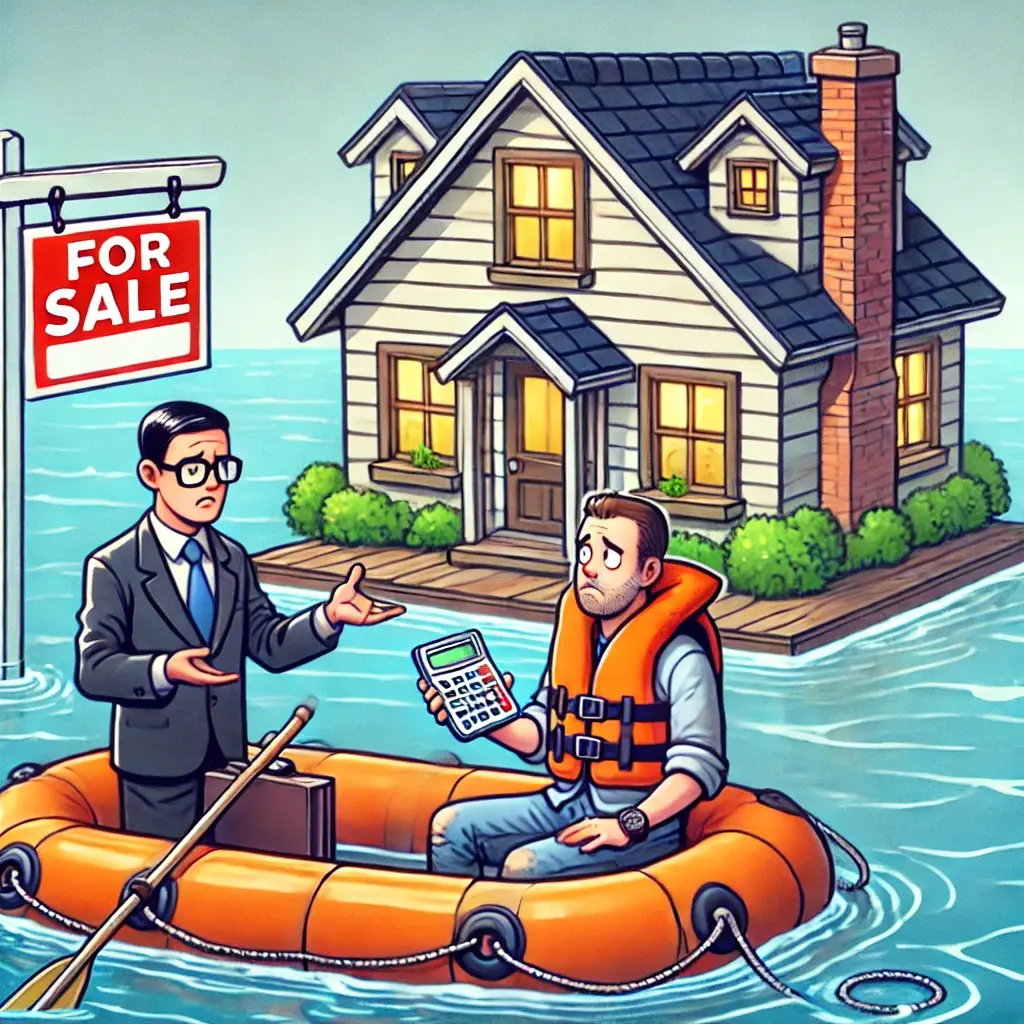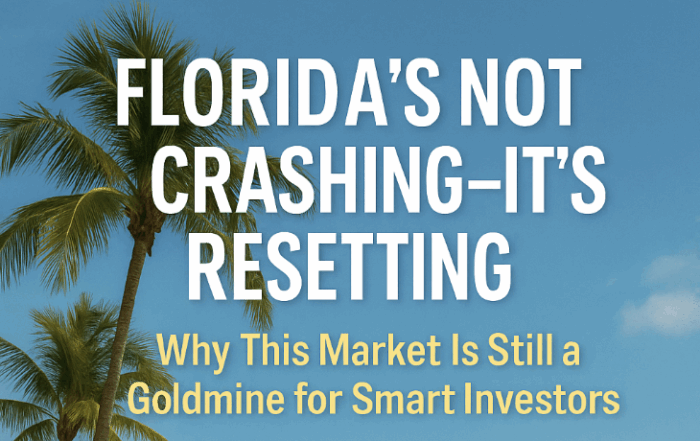
Investing in a High-Risk Flood Zone (AE) – Worth It or Hard Pass?
Introduction When it comes to real estate investing, risk assessment is everything. One of the biggest red flags for investors, especially in Florida, is buying in a high-risk AE flood zone. While some investors immediately dismiss properties in these areas, others see an opportunity for better deals and strong long-term appreciation.
So, the big question is: Should you invest in an AE flood zone, or is it a deal-breaker? Let’s break it down.
What Does AE Flood Zone Really Mean?
First things first—what in the world is an AE flood zone? Is it some kind of secret code for “Guaranteed Pool Included” or “Boats Welcome Instead of Cars”? Not exactly.
AE flood zones are areas designated by FEMA as having a 1% annual chance of flooding—also known as the dreaded 100-year flood zone. But don’t let the name fool you! This doesn’t mean a flood happens only once every 100 years. It just means there’s a 1% chance of flooding every single year. So, in reality, you could be bone dry for a century—or underwater next Tuesday.
Because of this, lenders require flood insurance, and premiums can range from “not too bad” to “should I just buy a boat instead?”
But here’s the reality:
-
Many prime waterfront and in-demand neighborhoods in Florida are in AE zones.
-
Flood zones don’t always mean the property floods. Many homes in these areas stay dry during major storms.
-
Insurance and mitigation strategies can significantly reduce financial risks.
Does AE Flood Zoning Hurt Resale Value?
One of the biggest concerns is resale. Investors worry that buyers will shy away, making it harder to sell the property. But does being in a flood zone really hurt resale value?
Consider this:
-
Waterfront homes in flood zones often sell for a premium, not a discount.
-
Limited supply in coastal markets means demand remains strong despite flood risk.
-
Buyers today are more informed and factor in flood insurance costs before purchasing.
-
Marketing matters — If you secure an affordable flood insurance policy, you can use it as a selling point.
🚀 Bottom Line: While an AE zone can reduce your buyer pool, it doesn’t automatically mean lower property value. The key is understanding local trends and buyer behavior.
Does AE Flood Zoning Make Renting Harder?
For investors focused on rental income, the big question is: Do tenants care about flood zones?
🔹 The short answer? Not really.
Most renters don’t ask about flood zones. What they care about is:
-
Location (proximity to work, schools, entertainment)
-
Price (rent affordability compared to nearby options)
-
Amenities & Condition (modern updates, safety, parking, etc.)
Even in flood-prone areas, demand for rentals remains high as long as the property is priced correctly.
🚀 Bottom Line: Flood zoning doesn’t impact rental demand unless the area has a history of severe flooding.
Can You Reduce Flood Insurance Costs?
One of the biggest deal-breakers for investors in AE zones is the cost of flood insurance. Some assume it’s always outrageously expensive. But that’s not always true.
Here’s how you can reduce flood insurance costs:
✅ Get an Elevation Certificate — This document measures how high your property sits above flood levels. Higher elevation = lower premiums. ✅ Mitigation Strategies — Adding flood vents, raising utilities, and installing sump pumps can lower insurance costs. ✅ Shop Around for Insurance — Some providers offer better rates based on individual property data. ✅ Check FEMA Flood Map Changes — Some properties get rezoned out of AE zones, which can eliminate flood insurance requirements altogether. ✅ Buy a Property That Didn’t Flood in Recent Storms — If a house stayed dry during a major hurricane, insurance providers may offer better rates.
🚀 Bottom Line: Flood insurance isn’t always a deal-breaker if you take the right steps to minimize costs.
Would You Still Do the Deal?
At the end of the day, the decision to invest in an AE flood zone property comes down to numbers and risk tolerance. Here’s a simple way to analyze the deal:
Key Questions to Ask:
1️⃣ Did the property flood in the last major storm? If not, that’s a good sign. 2️⃣ How much will flood insurance cost? Get real quotes before deciding. 3️⃣ Is the property priced below market value to compensate for risk? You should be getting a discount if there’s added risk. 4️⃣ Will rental income cover the added insurance cost? If yes, the deal might still be solid. 5️⃣ What’s the resale outlook? Is demand strong despite the flood zone?
🚀 Bottom Line: If the deal still makes financial sense after factoring in risk, go for it. If the numbers don’t add up, walk away.
Final Verdict: AE Flood Zones Are NOT Automatic Deal-Breakers
Too many investors immediately reject properties in AE flood zones without fully running the numbers. Yes, flood risk is real, but so is the opportunity to buy in high-demand locations at a discount and profit with smart risk management.
When to Buy in an AE Flood Zone:
✅ The house didn’t flood in the last major storm.
✅ Flood insurance costs are reasonable and fit the budget.
✅ The location is desirable and rental demand is strong.
✅ The property is priced below market value to justify the risk.
✅ The deal still cash flows well after adding flood insurance costs.
When to Walk Away:
❌ The house has flooded before (it will flood again).
❌ Flood insurance quotes are sky-high and kill the deal’s cash flow.
❌ The area has a bad track record of repeat flooding.
❌ You don’t have the financial buffer to handle unexpected flood damage.
Final Thought: Flood zones aren’t automatically bad investments—they’re just more complex. With the right due diligence and a solid risk-reward balance, investing in an AE flood zone property can be a smart move.
So, would YOU buy in an AE flood zone? 🤔 Drop your thoughts below!
Pick your expert. Book your free 15-minute consult now. We are here to help!
Our Top Articles
The Power of Home Equity: Utilizing Your Property’s Value
allanmcnabb2025-07-01T20:40:35+00:00July 1st, 2025|Comments Off on The Power of Home Equity: Utilizing Your Property’s Value
Your home is more than just a place to live; it’s one of the most significant financial [...]
Protected: Here’s How to Get Assignment Fees Financed (Even When Lenders Push Back)
Jorge Vazquez2025-07-01T20:45:37+00:00June 30th, 2025|Comments Off on Protected: Here’s How to Get Assignment Fees Financed (Even When Lenders Push Back)
This content is password protected. To view it please enter your password below: Password:
Florida’s Not Crashing—It’s Resetting: Why This Market Is Still a Goldmine for Smart Investors
Jorge Vazquez2025-06-28T22:52:38+00:00June 28th, 2025|Comments Off on Florida’s Not Crashing—It’s Resetting: Why This Market Is Still a Goldmine for Smart Investors
The so-called "decline" in Florida’s housing market is nothing like 2008. Back then, we were dealing [...]
Property Profit Academy:
✔ Learn to buy properties with little to no money down.
✔ Build a $10M portfolio step by step.
✔ Master strategies like BRRRR and house hacking.








